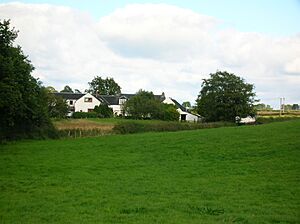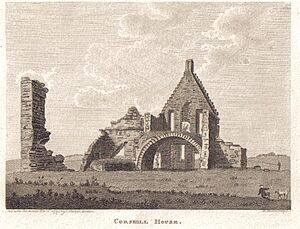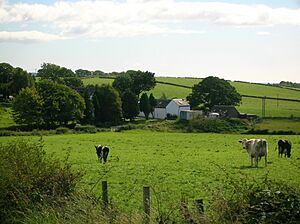Kirkwood Estate, East Ayrshire facts for kids
The Lands of Kirkwood (NS3947) were once a small estate in Stewarton, East Ayrshire. They were located between Stewarton and Dunlop. In 1678, Kirkwood became part of the larger Lainshaw Estate, known as the Lainshaw, Kirkwood, and Bridgehouse Estate. Kirkwood was also known in ancient times as Bloak Cunninghame. Today, Kirkwood is still a working farm.
Contents
History of Kirkwood
The Niven Family
The Niven family owned Kirkwood for many generations, starting around 1532. John Niven was an important person called a notary public in the early 1600s. His son, also named John Niven, is mentioned in records from 1606.
Later, James Nevin became the heir to his grandfather, James Nevin of Kirkwood, in 1635. The Niven family also owned nearby lands like Nether Oldhall.
Over the years, different members of the Niven family inherited Kirkwood. Each time, the estate passed from father to son, or sometimes to a grandson if a son died early. The family often made marriage agreements to secure their lands. For example, John Nevin, the third laird, married Christine Boyd.
The fifth laird was John Nevin, whose wife was Katherine Fairnellie. Their son, Hugh, passed away before he could inherit. So, Hugh's son, James, became the sixth laird of Kirkwood in 1635. James married Margaret Montgomery, but they did not have children. This meant the property then went to Hugh Nevin, who became the seventh laird.
Hugh Nevin was a respected official in Irvine. He was also a baillie, which was a type of judge or manager, for Sir Alexander Cunningham of Corshill. This shows how important the Niven family was in the area.
In 1666, Hugh Nevin of Kirkwood had to take someone to court to get money owed for land called Darnboig. This land had also belonged to the Niven family earlier.
Hugh Nevin was the last Niven to own Kirkwood. In 1667, the lands became part of the Eglinton estates. This happened when Hugh, the Earl of Eglinton, bought the lands from Hugh Nevin. Hugh Nevin passed away in 1677 and was buried in his family's burial place in Kilwinning.
The Role of a Baillie
A Baron-Baillie was a very important official in a barony court. They were like a judge and manager for the local lord. Their job involved holding court and making decisions about local matters.
Hugh Niven of Kirkwood was a baillie for Sir Alexander Cunningham of Corshill from at least 1673 until his death in 1677. Another baillie at that time was John Deanes, a merchant from Stewarton.
The baillie position was powerful and could be quite profitable. Baillies could collect fees for their services. For example, they might receive a day's labor from each tenant on the estate every year. They also collected fines for certain actions, like hunting game without permission. Another old right was the 'Herial Horse'. This meant the baillie could claim the best animal (like a horse or cow) that a tenant owned when they passed away. These practices were ways for the baillie to earn income in those times.
The Niven Surname
The Niven surname has been spelled in many ways over time, such as Nevin, Nivens, and Neving. It means 'little saint' and has been used in Ayrshire and Galloway since the late 1200s.
The Niven family also owned Monkredding House near Kilwinning for a long time. The Nevins of Kirkwood were related to the Nevins of Monkredding.
The Kirkwood Estate
The Kirkwood Estate was quite large. A map from 1799 shows many properties within it, including farms like Gunshill, Townend, and Coldhame. It also included areas like Bloak Mill and Kirkwood Moss. The entire Kirkwood Estate covered about 911 acres (3.69 square kilometers). When combined with the Lainshaw Estate, the total land was much larger.
The main house at Kirkwood was a mansion that stood until the 1790s. Old maps show it had a well-designed garden in front. There were also paths that led to an old road nearby. In 1799, there was a 'smiddy park' with buildings near the house.
The area around Kirkwood had quarries for stone like whinstone, limestone, and sandstone. There was also a limekiln near Kirkwood itself. The Spout Lynn is a pretty waterfall on the Gunshill Burn, close to Kirkwood.
Coal pits were also found in the area, including at Gouknest Park. These pits produced gas coal, which was used for fuel.
Religious Connections
Many place names in this area suggest a strong religious past. Names like Kirkwood, Chapel-lands Park, Kirkmuirs, and Kilbride farms point to old Christian or even pre-Christian sites. For example, Kilbride is linked to Bride, or St. Brigid. She was an ancient Celtic Goddess associated with spring, healing, and sacred wells. The name Canaan at Kirkmuir was used as early as 1779.
The Tam o'Shanter Story
Towards the end of the 1600s, some Niven brothers from the Kilwinning area moved to Girvan. One of them, John Niven, became a blacksmith. He was known for designing and building carts with wheels that turned on a fixed axle. This was special because most farmers still used sleds back then.
It is believed that John Niven is the blacksmith mentioned in Robert Burns' famous poem, 'Tam o'Shanter'. His son, Robert, might even have been the miller in the poem.
|
Fun Facts
Stories of ghosts at North Kilbride include an old man often seen in a rocking chair. People also report hearing horses galloping on the abandoned road to Irvinehill Farm.
See also
- Monkredding House, North Ayrshire
- Lainshaw Estate
- Chapeltoun
- Barony of Aiket





